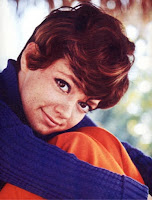After yesterday's rant about the decline of good, honest music in favour of prepackaged boy bands, I felt today's post should relate in some way. So, my dears, I've chosen for today's post, the sirens of French Bubblegum Pop...Yé-yé girls.
In the very early 1960s, a new music scene was slowly emerging. Born in France and reinvented all over Europe, yé-yé would have just as much of an impact on fashion as it would the world of music.
Coming out of the restrained 1950s, music with a little sex appeal was welcomed. Yé-yé delivered. Most of the songs flirted with the subject of sex, but not in an overtly sexual way.
 Yé-yé girls were young, many in their early teens, and they dressed young...either in bows and frills or in androgenous boyish attire and often a mix of the two. It was as if Humbert Humbert had been left in charge of the music industry. And it wasn't actually a bad thing! It was cute, it was upbeat, it was fun to dance to...and it still is!
Yé-yé girls were young, many in their early teens, and they dressed young...either in bows and frills or in androgenous boyish attire and often a mix of the two. It was as if Humbert Humbert had been left in charge of the music industry. And it wasn't actually a bad thing! It was cute, it was upbeat, it was fun to dance to...and it still is!Yé-yé music and fashion quickly spread throughout Europe and Canada leaving it's mark on another emerging fashion subculture, Mod. There were many yé-yé girls, and boys, from all over the world. I've chosen to focus on the ones who have a look and a sound that I personally find the most inspiring.
France Gall--Arguably the most famous of the yé-yé girls, she began her career at sixteen when her first single, "Ne sois pas si bête", was released in 1963. it quickly became a hit.

This led to collaborations with many influential composers, namely Serge Gainsborough. In 1965, she sang the winning tune, Gainsborough's "Poupée de cire, poupée de son" for the Eurovision Song Contest. It's lyrics have, as do most of Gainsborough's, a double meaning. France later took offense to "Wax Doll, Singing Doll" as well as to the sexual connotations in another Gainsborough penned song, "Sucettes" when she became old enough to understand the allusions of the songs...later she would even refuse to perform her award winning "Poupée de cire". It seemed Hummy had lost his little Lo.
Françoise Hardy--Her first hit, in 1962 was actually a B side, "Tous les garçons et les filles".
 She continued her music career while also pursuing acting...one small part was in What's New Pussycat where she plays the mayor's secretary. Françoise later married fellow yé-yé singer, Jacques Dutronc.
She continued her music career while also pursuing acting...one small part was in What's New Pussycat where she plays the mayor's secretary. Françoise later married fellow yé-yé singer, Jacques Dutronc. Sylvie Vartan--Although Bulgarian by birth, Sylvie learned French after moving to France with her family in 1952. Her first break came in 1961, when she was asked to sing backup for her brother's friend, Frankie Jordan, on a B side of one of his releases. Like many yé-yé's, much of Sylvie's repertoire consisted of French versions of songs already made popular by other artists, including Little Eva's "Locomotion", Ray Charles' "What I Say", and Mel Torme's "I'm Comin' Home, Baby". Quite frankly, I enjoy some of her and other yé-yé remakes better than the originals! And she's bloody adorable as well...I think I may try her side swoop hair-do one day!!
Sylvie Vartan--Although Bulgarian by birth, Sylvie learned French after moving to France with her family in 1952. Her first break came in 1961, when she was asked to sing backup for her brother's friend, Frankie Jordan, on a B side of one of his releases. Like many yé-yé's, much of Sylvie's repertoire consisted of French versions of songs already made popular by other artists, including Little Eva's "Locomotion", Ray Charles' "What I Say", and Mel Torme's "I'm Comin' Home, Baby". Quite frankly, I enjoy some of her and other yé-yé remakes better than the originals! And she's bloody adorable as well...I think I may try her side swoop hair-do one day!! Rita Pavone--Though Italian, Pavone is still a bonafied a yé-yé. With her androgynous style, little boy cuteness, and precocious personality, she endeared herself not only to European audiences, but also American television viewers, making periodic appearances on Ed Sullivan throughout the last half of the 1960's. To me, she is the epitome of the mod girl...the real, pre '66 ones!
Rita Pavone--Though Italian, Pavone is still a bonafied a yé-yé. With her androgynous style, little boy cuteness, and precocious personality, she endeared herself not only to European audiences, but also American television viewers, making periodic appearances on Ed Sullivan throughout the last half of the 1960's. To me, she is the epitome of the mod girl...the real, pre '66 ones!Here are some of my favourite yé-yé girls...and boys...doing what they do best! I've tried to find original scopitones for as many as I could!:
No comments:
Post a Comment